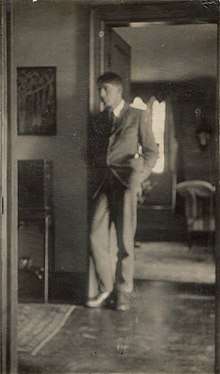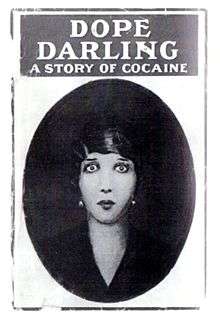David Garnett
David Garnett (9 March 1892 – 17 February 1981) was a British writer and publisher. As a child, he had a cloak made of rabbit skin and thus received the nickname "Bunny", by which he was known to friends and intimates all his life.
David Garnett | |
|---|---|
 Garnett in 1920, by Lady Ottoline Morrell | |
| Born | 9 March 1892 Brighton, East Sussex, UK |
| Died | 17 February 1981 (aged 88) |
| Spouse(s) | Rachel Marshall Angelica Bell (1942–1981, his death) |
| Children | 6, including Amaryllis Garnett |
| Parent(s) | Edward Garnett (1868–1937) Constance Black (1861–1946) |
Early life
Garnett was born in Brighton, East Sussex, the only child of writer, critic and publisher Edward Garnett and his wife Constance Clara Black, a translator of Russian. His paternal grandfather and great-grandfather both worked at what is now the British Library, then within the British Museum.
As a conscientious objector in the First World War, Garnett worked on fruit farms in Suffolk and Sussex with his lover Duncan Grant.
Work
A prominent member of the Bloomsbury Group, Garnett received literary recognition when his novel Lady into Fox, an allegorical fantasy,[1] was awarded the 1922 James Tait Black Memorial Prize for fiction. He ran a bookshop near the British Museum with Francis Birrell during the 1920s. He also founded (with Francis Meynell) the Nonesuch Press. He wrote the novel Aspects of Love (1955), on which the later Andrew Lloyd Webber musical of the same name was based.
Personal life
His first wife was the illustrator Rachel "Ray" Marshall (1891–1940), sister of the translator and diarist Frances Partridge. He and Ray, whose woodcuts appear in some of Garnett's books, had two sons, the older of which was Richard Garnett (1923–2013), the writer.[2] Ray died relatively young of breast cancer.
Garnett was bisexual, as were several members of the artistic and literary Bloomsbury Group, and he had affairs with Francis Birrell and Duncan Grant. On 25 December 1918 he was present at the birth of Grant's daughter by Vanessa Bell, Angelica, who was accepted by Vanessa's husband Clive Bell. Shortly afterwards he wrote to a friend: "I think of marrying it. When she is 20, I shall be 46 – will it be scandalous?" On 8 May 1942, when Angelica was in her early twenties, they did marry, to the horror of her parents. She did not find out until much later that her husband had been a lover of her father.
The Garnetts lived at Hilton Hall, near St Ives in Huntingdonshire, where David Garnett kept a herd of Jersey cows.[3]
They had four daughters: in order, Amaryllis, Henrietta, and the twins Nerissa and Frances; eventually the couple separated. Amaryllis Virginia Garnett (1943–1973) was an actress who had a small part in Harold Pinter's film adaptation of The Go-Between (1970). She drowned in the Thames, aged 29. Henrietta Garnett married Lytton Burgo Partridge, her father's nephew by his first wife Ray, but was left a widow with a newborn infant when she was 18;[4] she oversaw the legacies of both David Garnett and Duncan Grant. Nerissa Garnett (1946–2004) was an artist, ceramicist, and photographer. Fanny (Frances) Garnett moved to France where she became a farmer.
Later life
After his separation from Angelica, Garnett moved to France and lived in the grounds at the Château de Charry, Montcuq (near Cahors), in a house leased to him by the owners, Jo and Angela d'Urville.[5] Garnett continued to write and lived there until his death in 1981.
List of selected publications

- Dope Darling (1919), novel, as Leda Burke
- Lady into Fox (1922), novel
- A Man in the Zoo (1924), novel
- The Sailor's Return (1925), novel
- Go She Must! (1927), novel
- The Old Dove Cote (1928), short stories
- A Voyage to the Island of the Articoles by André Maurois (1928), translator
- Never Be a Bookseller (1929), memoirs
- No Love (1929), novel
- The Grasshoppers Come (1931)
- A Terrible Day (1932)
- A Rabbit in the Air. Notes from a diary kept while learning to handle an aeroplane (1932)
- Pocahontas (1933)
- Letters from John Galsworthy 1900–1932 (1934)
- Beany-Eye (1935)
- The Letters of T. E. Lawrence (1938), editor
- The Battle of Britain (1941)
- War in the Air (1941)
- The Campaign in Greece and Crete (1942)
- The Novels of Thomas Love Peacock (1948), editor
- Selected Letters of T. E. Lawrence (1952), editor
- The Golden Echo (1953), autobiography (i)
- The Flowers of the Forest (1955), autobiography (ii)
- Aspects of Love (1955)
- A Shot in the Dark (1958)
- A Net for Venus (1959) novel
- The Familiar Faces (1962), autobiography (iii)
- Two by Two (1963), novel
- 338171 T. E. (Lawrence of Arabia) by Victoria Ocampo (1963), translator
- Ulterior Motives (1966) novel
- The White/Garnett Letters (1968), correspondence with T. H. White
- Carrington: Letters & Extracts From Her Diaries (1970)
- First "Hippy" Revolution (1970)
- A Clean Slate (1971)
- The Sons of the Falcon (1972), novel
- Purl and Plain (1973) stories
- Plough Over the Bones (1973), novel
- The Master Cat (1974)
- Up She Rises (1977)
- Great Friends. Portraits of Seventeen Writers (1979)
- David Garnett. C.B.E. A Writer's Library (1983)
- The Secret History of PWE : The Political Warfare Executive, 1939–1945 (2002)
References
- John Clute Lady into Fox, in Frank N. Magill (ed.), Survey of Modern Fantasy Literature, Vol 2. Englewood Cliffs, NJ: Salem Press, Inc., 1983, pp. 863–866.
- Nicholas Barker, "Richard Garnett: Typographer, editor and writer who grew up amid the Bloomsbury group" (obituary), The Independent, 5 June 2013.
- Liz Hodgkinson, "Poisoned Legacy of the Bloomsbury Group", Daily Mail, May 2012.
- Adam Kuper, Incest and Influence: The Private Life of Bourgeois England, Harvard University Press, 2009, p. 242, ISBN 0-674-03589-5.
- Sarah Knights (2015), Bloomsbury's Outsider: A Life of David Garnett, Bloomsbury Reader (632 pp.), p. 509. ISBN 978-1-4482-1545-4.
Bibliography
- Knights, Sarah (2015). Bloomsbury's Outsider: A Life of David Garnett. Bloomsbury Publishing. ISBN 978-1-4482-1544-7.CS1 maint: ref=harv (link)
- Taylor, D. J. (23 July 2015). "Bloomsbury's Outsider: A Life of David Garnett by Sarah Knights". The Guardian (Review).
- Wade, Francesca (26 June 2015). "Dangerous liaisons among the Bloomsbury set". Daily Telegraph (Review).CS1 maint: ref=harv (link)
- Heilbrun, Carolyn G., The Garnett Family (1961), also on Richard Garnett, Jeremiah Garnett, Edward Garnett, Constance Garnett.
External links
| Wikimedia Commons has media related to Bloomsbury Group. |
- Liz Hodgkinson, "Poisoned Legacy of the Bloomsbury Group", Daily Mail, May 2012.
- Works by David Garnett at Project Gutenberg
- Works by or about David Garnett at Internet Archive
- Works by David Garnett at LibriVox (public domain audiobooks)
